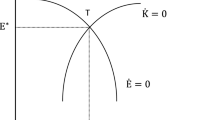Abstract
This paper explores the Nash equilibrium dynamics of environmental and human capital in an overlapping generations model. Environmental capital is degraded by consumption but can be improved by the voluntary provision of environmental goods. Human capital is formed by a child's learning effort together with his parent's human capital and environmental capital. We show that the laissez faire economy will be either stagnant, growing, or collapsing in the long-run, depending on the returns to scale of the learning technology with respect to the two kinds of capital, the initial state of the economy, and the relative price of the environmental and consumption goods. We also examine the role of the consumption tax policy of both the short-lived and long-lived government for correcting environmental externalities.
Similar content being viewed by others
References
Coase, R. (1960). “The Problem of Social Cost.” Journal of Law and Economics 3, 1–44.
Diamond, P. (1965). “National Debt in a Neoclassical Growth Model.” American Economic Review 55, 1126–150.
Glomm, G., and B. Ravikumar. (1992). “Public versus Private Investment in Human Capital: Endogenous Growth and Income Inequality.” Journal of Political Economy 100, 818–833.
Gradus, R., and S. Smulders. (1993). “The Trade−Off Between Environmental Care and Long−Term Growth—Pollution in Three Prototype Growth Models.” Journal of Economics 58, 25–51.
Hochman, O., and E. Hochman. (1980) “Regeneration, Public Goods, and Economic Growth.” Econometrica 48, 1233–1250.
Ihori, T. (1996a). “Environmental Externalities and Consumption Taxes.” Mimeo.
Ihori, T. (1996b). “Environmental Externalities and Growth.” Mimeo.
John, A., and R. Pecchenino. (1994). “An Overlapping Generations Model of Growth and the Environment.” Economic Journal 104, 1393–1410.
Lucas, R. (1988). “On the Mechanics of Economic Development.” Journal of Monetary Economics 21, 3–42.
Yoshida, M. (1996). “A Model of Growth and the Environment with a Threshold Effect of Pollution.” Mimeo.
Author information
Authors and Affiliations
Rights and permissions
About this article
Cite this article
Yoshida, M. Nash Equilibrium Dynamics of Environmental and Human Capital. International Tax and Public Finance 5, 357–377 (1998). https://doi.org/10.1023/A:1008690328658
Issue Date:
DOI: https://doi.org/10.1023/A:1008690328658




